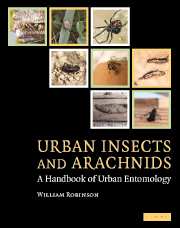Book contents
- Frontmatter
- Contents
- Preface
- Part I Urban entomology
- Part II Insects in the urban environment
- 4 Blattaria
- 5 Coleoptera
- 6 Collembola, Dermaptera
- 7 Diptera, Ephemeroptera
- 8 Hemiptera, Homoptera
- 9 Hymenoptera
- 10 Isoptera
- 11 Lepidoptera
- 12 Mantodea, Neuroptera
- 13 Orthoptera, Phasmatodea
- 14 Phthiraptera
- 15 Plecoptera, Psocoptera
- 16 Siphonaptera
- 17 Thysanoptera, Thysanura, Trichoptera
- Part III Other arthropods in the urban environment
- Family, genus, species index
- Index
- References
- Frontmatter
- Contents
- Preface
- Part I Urban entomology
- Part II Insects in the urban environment
- 4 Blattaria
- 5 Coleoptera
- 6 Collembola, Dermaptera
- 7 Diptera, Ephemeroptera
- 8 Hemiptera, Homoptera
- 9 Hymenoptera
- 10 Isoptera
- 11 Lepidoptera
- 12 Mantodea, Neuroptera
- 13 Orthoptera, Phasmatodea
- 14 Phthiraptera
- 15 Plecoptera, Psocoptera
- 16 Siphonaptera
- 17 Thysanoptera, Thysanura, Trichoptera
- Part III Other arthropods in the urban environment
- Family, genus, species index
- Index
- References
Summary
Introduction
Beetles comprise the largest order of insects, with over a quarter of a million described species. They have four wings, with the front pair thickened, leathery, or hardened, and usually covering the hind wings. Their chewing mouthparts are well developed in the adults and larvae. Mandibles range from slender and sharp use for predaceous habits, to large and toothed, used to crush plant and animal material, or gnawing wood. In weevils, the front of the head is produced into an elongated snout, with the mandibles at the end. Development in this order includes egg, larva, pupa, and adult stages. Larvae vary considerably in form, but most are elongate and flattened or grub-like. The life cycle varies in length to provide several generations a year to one generation in several years. Overwintering generally occurs as a larva or pupa in protected sites, but some species overwinter as adults in large aggregations.
Wood is a source of food and harborage for several species of beetles. However, cellulose and lignin that give wood strength and durability are not easily converted to food. Only a small number of insects actually derive nutrition from wood. Others, such as carpenter ants and carpenter bees, have mouthparts strong enough to tunnel into sound or slightly decayed wood, but their gut is not equipped with the enzymes or microorganisms necessary to convert it into food components.
- Type
- Chapter
- Information
- Urban Insects and ArachnidsA Handbook of Urban Entomology, pp. 65 - 138Publisher: Cambridge University PressPrint publication year: 2005
References
- 1
- Cited by

